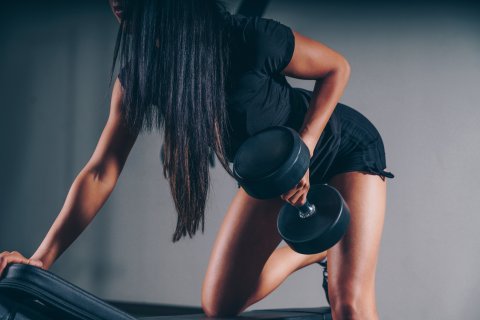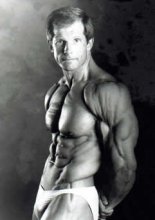You are here
Home ›Back to the Gym

Fitness is for everybody. Depicted as The Incredible Machine by the National Geographic Society, the human body has the capacity for remarkable achievements in strength and endurance. We are considered the most dangerous predator on earth and if well conditioned, we are built for stamina and designed beautifully for adaptation.
Unfortunately, many of us have lost our ability to adapt because we have lost our condition.
Our physical bodies are comprised of about 100 trillion cells. Our brain alone, which is mostly fat and consists of over 10 billion cells, is capable of thinking at 800 words per minute. Our eyes have one hundred million receptors. Our ears contain 24,000 fibers. Our skeleton consists of over 200 bones, which serves as the framework for nearly 700 muscles. We have 12,000 meters of nerve fiber and 100,000 kilometers of blood vessels, which lead to a heart that pumps over 6000 liters of blood each day. Health is the presence of function…optimum function. It means we are fit and ready for action!
Exercise is Not an Option!
Exercise is a component of physical activity, which refers to any expenditure of energy ranging from very low to very high levels of exertion. The difference between exercise and physical activity is that exercise is structured and designed specifically to achieve, maintain and improve physical fitness. The sole purpose of exercise is to improve our ability to perform within the context of optimum health.
Although perceived as exercise and considered by some as a viable alternative to “working-out”, bricklaying, landscaping, construction labor, housework, farming, waitressing and virtually all sports are not true forms of exercise. Instead, they are more correctly defined as forms of physical activity.
Hard physical work is good for the body and soul, especially when performed in the fresh air and natural light of the outdoors. Many sports develop a kind of “special” sport-specific physical condition, as well as discipline and self-confidence. But in the context of optimum development above and beyond what happens to the body as it adapts to the challenge of unloading a boxcar or running a 10K, exercise has the edge as the “means.” Physical activity is viewed as the “end”.

Once our bodies adapt to the physical demands of labor and sport, they stop improving. It’s a law like the law of gravity. Jump off a table and ten out of ten times you’ll always go down, you’ll never go up and it’s the same with our physical condition. We lose if we don’t use it. To get better at something, you must make it more difficult. You must challenge status quo, and if you’re not getting better, you’re actually sliding downhill.
The “means” to do the job or play the sport better with greater ease and less risk of injury, is the training or exercise program on top of these activities. It’s not one or the other, it’s both, and of course you have to build a house to get better at building a house. But how many construction workers do you know with bad backs and beer guts? I know it sounds crazy, but if you train with weights and incorporate some aerobics and stretching on a regular basis in addition to whatever it is you currently do, you not only can do it better, but you can also reach a higher level of health. That means you’ll probably live longer and feel better too.
As we improve our level of physical fitness, we will experience less decay as we age. That means less pain and less need for medication. Our energy level and vital capacity rises as our heart and lungs adapt to increased oxygen consumption. Physical recreation and sport becomes more attractive because energy is a component of self-motivation. You begin to notice less fatigue as you move about in your daily routine. You feel like a kid again. This equates to more freedom, which like happiness, is the summun bonum of life.
The Ideal Workout Routine
From the science of exercise physiology, we know that health-related physical fitness consists of optimizing muscle strength, muscle endurance, joint flexibility, aerobic capacity and body composition. These five components can be measured and compared to standards, which reflect ideal form and function. Therefore, a good well-rounded exercise program should include patterns and forms of movement, which develop all of these facets, meaning the muscle-head’s need to stretch and do a little aerobics, and the aerobic queens need to pump some iron.
Resistance Training
Getting back to the gym is a good move, because pushing and pulling weights against the force of gravity is the best way to maintain and build lean body mass. You can burn calories with aerobics but you can’t build muscle, and prolonged aerobic exercise alone actually causes muscle loss and increases the risk of osteoporosis through increased oxidation. Muscle fibers contain little furnaces called mitochondria, which oxidize or “burn” fatty acids for fuel. More muscle means you burn more calories from fat just standing still. And one more thing. Muscle supplies immune cells with the glutamine they require for their own survival and replication, so a gradual muscle loss over decades (10-25%) isn’t very good for your immune system.
Lifting heavier weights with longer rest periods between sets (2-3 minutes) tends to increase muscle size and strength, whereas lighter training with a higher repetition range (12-20) improves muscle endurance. Each major muscle group requires full and complete contraction with resistance applied throughout its natural range of motion. Exercise technique should also be executed with precision and pride. I recommend training one body part per workout, such as chest or arms, five days per week. This allows complete body coverage each week, provides adequate stimulation and recovery, and keeps individual training sessions under one hour.
Muscle Fibers
Comprised of two primary fiber types, (type I and type II) skeletal muscle responds differently to the same exercise performed with a different load. A heavy set of 3 reps in the bench press or squat activates a range of fibers and motor units in a different way when compared to a lighter set of 18 reps. Only those fiber types needed for the muscle work get involved, so you have to be specific in your training format. Do you want size, strength, endurance or a balance of all three? Different muscles also have different percentages of fiber types, and to make matters even more confusing, these percentages vary from person to person.
Type I fibers, which are also called slow-twitch or red fibers, are best suited for endurance and high-volume work, so they’re mostly used in events like marathons and tennis. Type II fibers, called fast-twitch or white fibers, are explosive by nature but have little endurance. They grow thicker faster when stimulated through intense training, and give more dimension to one’s physique. Sprinters, hammer throwers and powerlifters for example, concentrate on heavier, explosive exercise training to increase power and muscle torque.
For general health and fitness for both men & women, I recommend heavy and light resistance training for maximum value. By “heavy” and “light” I’m speaking in the relative sense, so don’t compare yourself to other people. Use your personal existing level of strength and development as a reference.
On Day 2 for example, include a maximum of four exercises (ten total sets) for chest, such as BB bench press (4 sets), incline DB press (2 sets), DB flyes (2 sets) and Cable Crossovers (2 sets). When bench pressing (after 2-3 warm-up sets) perform 2 “heavy” sets of 3-6 reps, then come down in weight 20-40% and perform 2 “light” sets of 12-20 reps.
The first 2 "heavy" sets are the most intense, and consequently, will engage a predominance of "white" fast-twitch muscle fibers, encourage greater growth hormone and testosterone release, as well as set in motion the formation of IGF-1, which regulates repair and growth. The second 2 “flush” or lighter endurance sets of 8-12 reps will engorge muscle cells with fresh blood for a “pumping effect” and increase capillary density around muscle fibers, which can contribute up to 25% of a muscle’s dimension.
Perform 2 sets of 8-12 reps for the three remaining chest exercises, which require no additional warm-up.
Sample Exercise Routine
| Day 1 | Day 2 | Day 3 | Day 4 | Day 5 |
|---|---|---|---|---|
| Warm-Up | Warm-Up | Warm-Up | Warm-Up | Warm-Up |
| Legs | Chest | Back | Shoulders | Arms |
| Core | Core | Core | Core | Core |
| Cardio | Cardio | Cardio | Cardio | Cardio |
| Stretch | Stretch | Stretch | Stretch | Stretch |
Have efficient and productive workouts consistently. Organized planning is Napoleon Hill’s sixth principle for achieving success in life. To quote from his classic book Think & Grow Rich, "…everything man creates or acquires begins in the form of desire, that desire is taken on the first lap of its journey, from the abstract to the concrete, into the workshop of the imagination, where plans for its transition are created and organized. Your achievement can be no greater than your plans are sound."
Photo by Nicole De Khors from Burst
And one of my favorites from the Austrian Oak Arnold Schwarzenegger,
"You work out a plan, then you make that move. Anything is possible if you work at it."

Stay well and live free!
Dr.C
- Log in to post comments